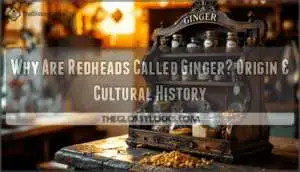This site is supported by our readers. We may earn a commission, at no cost to you, if you purchase through links.
 You’ve probably heard "ginger" tossed around as shorthand for red hair, but the nickname didn’t start with hair at all—it came from a spice rack. The culinary root that gives us zingy flavor and warm reddish-brown hues lent its name to redheads somewhere along the line, though pinning down exactly when and why involves cockfighting slang, Victorian slang dictionaries, and centuries of linguistic drift.
You’ve probably heard "ginger" tossed around as shorthand for red hair, but the nickname didn’t start with hair at all—it came from a spice rack. The culinary root that gives us zingy flavor and warm reddish-brown hues lent its name to redheads somewhere along the line, though pinning down exactly when and why involves cockfighting slang, Victorian slang dictionaries, and centuries of linguistic drift.
What began as a color comparison in 18th-century Britain evolved into something far more complex: a term that can signal affection, identity, or insult depending on who’s saying it and where. Understanding why redheads became "gingers" means tracing a path through etymology, cultural attitudes, and the peculiar ways language latches onto physical traits.
Table Of Contents
Key Takeaways
- The term "ginger" for redheads originated in 18th-century Britain from cockfighting slang, where "ginger-pated" described red-feathered roosters before transferring to humans with similar hair coloring.
- The nickname stuck because the ginger spice’s warm reddish-brown hues visually matched the copper and auburn tones of natural red hair, making it a vivid and accessible descriptor that outlasted alternatives like "carroty" or "auburn."
- While initially neutral, "ginger" evolved into a loaded term carrying both affectionate and insulting connotations depending on context, with over 90% of UK red-haired men reporting bullying experiences tied to the label.
- Red hair won’t disappear genetically since the MC1R gene mutation responsible for it persists as a recessive trait across generations, even when not visibly expressed in every individual.
Why Are Redheads Called ‘Ginger’?
You’ve probably heard redheads called "ginger" and wondered where that nickname came from. The term has roots that stretch back centuries, weaving through cockfighting pits, spice jars, and cultural shifts across English-speaking nations.
Let’s unpack what "ginger" actually means, how it’s used today, and why it still sticks around.
Brief Definition of ‘ginger’ as It Relates to Red Hair
You’ve probably heard someone with fiery locks called a ginger—but where did this nickname for redheads actually come from, and what does it really mean?
Essentially, ginger describes people with red hair, a trait caused by hair color genetics linked to the MC1R gene. This redhead label carries layers of cultural significance, from playful banter to stereotypes that shape how we see this rare hair color.
The ginger etymology traces back centuries, revealing how a simple spice name became shorthand for the world’s rarest natural hue.
Overview of The Term’s Usage in English-speaking Countries
Across the UK, Ireland, Australia, and North America, ginger has settled into everyday vocabulary with wildly different meanings depending on who’s saying it—and how. Regional dialect variations show how language evolution transforms a simple descriptor into something loaded with social perception:
- In Britain, it’s casual playground slang—sometimes affectionate, often cutting
- Irish communities embrace it with pride, reclaiming redhead identity
- American usage arrived later, filtered through media stereotypes
- Australian banter treats it as fair game, like any physical trait
- Dictionary definitions remain neutral, but cultural significance runs deeper than etymology suggests
Current Perceptions and Prevalence of The Term
Today, the term walks a tightrope between casual shorthand and loaded insult, with linguistic corpus studies showing neutral or affectionate uses finally overtaking negative ones in digital spaces after 2018.
Redhead empowerment movements and cultural sensitivity campaigns have reshaped social perceptions of red hair, though hair color bias persists in pockets—especially where ginger stereotypes fuel playground teasing.
Social media impact cuts both ways: viral celebrations of redhead identity coexist with discrimination against redheads, reminding us that use of the term ginger still depends on context, intent, and who’s listening.
Historical Origins of The Term ‘Ginger’
The story of how "ginger" became shorthand for red hair isn’t straightforward—it winds through old dictionaries, rowdy cockpits, and kitchen spice jars.
You’ll find the term popping up in surprising places, from 18th-century slang to fighting rooster nicknames.
Let’s trace where this colorful word actually came from.
First Documented Uses in Literature and Slang
The paper trail starts surprisingly early. You’ll find "ginger" linked to red hair in Francis Grose’s 1785 dictionary, where "ginger-pated" meant red-haired—borrowed straight from cockfighting slang. Here’s how the etymology unfolded:
- 1785: Grose’s dictionary marks the first lexical appearance linking ginger to human hair color
- Early 1800s: Regional British dialects adopted "ginger-hackled" and "ginger-headed" as common descriptors
- 1852: The term solidified in mainstream English usage, moving beyond specialized slang
- Victorian era: Literary references to "ginger-haired" characters surged, replacing older terms like "carroty"
- Mid-1900s: The word became entrenched in British colloquial speech, appearing across media
This historical slang term’s journey from cockpits to everyday color terminology reveals how vivid descriptors stick. The origins of red hair have been studied in the context of ancient redheads history, providing insight into its cultural significance.
Cockfighting Connection and Regional Dialects
Behind the farmyard slang lies something surprising—you’ll trace "ginger" back to fighting cocks in 18th-century England. Francis Grose’s 1785 dictionary captured "ginger-pated" from cockfighting circles, where red-feathered roosters dominated the pits. Rural dialects adopted this vivid descriptor, spreading through working-class communities invested in the sport. The etymology of ginger is rooted in its spice trade history, which has been well-documented.
| Period | Regional Usage |
|---|---|
| 1785 | Francis Grose documents "ginger pated" in cockfighting vernacular |
| 1825 | Northern England glossaries record "ginger-heckl’d" for red hair |
| 1828 | Craven dialect lists "ginger-pated" alongside "carroty-pated" |
| 1850s | Cockfighting connection fades as term enters mainstream slang |
| 1900s | Provincial word usage solidifies across British regional dialects |
The cockfighting history shaped how "ginger" traveled from sport arenas into everyday language, cementing its place in regional slang long before mass media existed.
Red Ginger Plant and Ginger Spice Color Association
While cockpits gave us the slang, the spice itself sealed the connection—ginger root‘s warm reddish-brown tones mirror the copper and auburn shades that crown natural redheads. You’ll find the botanical links weren’t accidental:
- Ginger Roots exported through spice trade routes displayed the same russet hues
- Red Ginger Plant flowers showcased vivid crimson tones matching bright red hair
- Color Palette charts from the 15th century documented "ginger colour" as reddish-brown
- Flavor Profiles in baked goods produced golden-copper crusts resembling natural redhead tones
- Medieval dyers used ginger-inspired pigments to replicate these warm shades
The visual match made "ginger" stick as shorthand for red-haired folks.
Etymology and Color Associations
The word "ginger" didn’t start as a hair color term—it came from somewhere else entirely. To understand how it became shorthand for red hair, you need to look at where the word itself comes from and how people started using it to describe color.
Here’s how the linguistic journey unfolded and how "ginger" stacks up against other redhead labels.
Linguistic Roots of The Word ‘ginger’
You might trace the word "ginger" back through a fascinating etymological evolution spanning continents and millennia. The term originates from Sanskrit śṛṅgavera, meaning "horn body," likely influenced by earlier Dravidian roots like Tamil iñci-vēr.
Through medieval trade routes, phonetic shifts transformed it: Sanskrit to Prakrit singabera, then Greek zingiberis, Latin gingiber, and finally Old English gingifer by the 11th century. This linguistic journey reflects how spice commerce shaped language families across history.
Evolution of ‘ginger’ as a Color Descriptor
By the 15th century, the spice had lent its warm reddish-brown hue to the English language—suddenly, "ginger" wasn’t just something you grated into your stew, but a way to describe the color itself.
The Oxford English Dictionary traces this semantic evolution, showing how the term shifted from botanical origin to hair color descriptions. You’ll find historical dye records from the 18th century documenting "ginger" pigments formulated from iron oxides—color terms mirroring the spice’s distinctive tint.
This etymological analysis reveals how hair tinting vocabularies emerged from everyday objects, embedding cultural significance into redhead stereotypes through color perception alone.
Comparison to Other Hair Color Terms (carroty, Auburn, Etc.)
Ginger" wasn’t the only way English speakers christened redheads—"carroty," "auburn," and a whole spectrum of other terms competed for linguistic dominance, each carrying its own baggage of affection, insult, or simple description.
"Carroty-pated" landed squarely in insult territory, evoking the vegetable’s bright orange shock. Auburn, borrowed from Latin alburnus (whitish), described refined copper tones—think dignified rather than mockable.
Each hair color description carved out its own niche in the redhead stereotypes landscape.
Social and Cultural Impact of ‘Ginger’
The term "ginger" hasn’t stayed static—it’s shifted from a casual descriptor to something more loaded, shaped by everything from TV shows to internet culture. How people use it and feel about it has changed over the decades, reflecting broader attitudes toward redheads.
Let’s look at how media, stereotypes, and online spaces have transformed what "ginger" really means.
Shifting Attitudes and Stereotypes Over Time
For centuries, redheads carried the weight of medieval superstition and Renaissance moralizing—think witch trials and literary villains. But cultural shifts and media influence began chipping away at those old stereotypes.
Early 20th-century films leaned on comic relief roles, yet by the 2000s, complex protagonists in Harry Potter and Brave reshaped social perception of red hair.
Today, redhead empowerment thrives through festivals and online communities, transforming negative connotations of ginger into badges of pride and belonging.
Influence of Media and Popular Culture (e.g., Gilligan’s Island)
Television cemented "ginger" in American vocabulary—and no show did more than Gilligan’s Island, where Tina Louise’s red-haired character turned the term into a household name. The show’s cultural impact extended beyond simple TV representations:
- Ginger Grant became a media archetype for glamorous redheads, shaping social influence around red hair visibility
- The Mary Ann versus Ginger debate reinforced redheads and the term ginger as shorthand for specific personality traits
- Gilligan’s Island influence normalized the nickname across generations, cementing its film portrayals and media stereotypes in pop culture conversations about red hair
Use in Online Communities and Modern Slang
What began on TV screens soon exploded across forums, memes, and social media—where "ginger" took on a life of its own, swinging wildly between playful banter and outright cruelty.
Online communities amplified the nickname through Urban Dictionary entries and viral trends, but digital culture’s dark side emerged too—cyberbullying and online harassment targeting redheads spiked after 2008’s "Kick a Ginger" Facebook incident, forcing internet culture to reckon with how slang becomes ammunition.
Redheads’ Perspectives on The Term
The term "ginger" doesn’t land the same way for everyone with red hair. Some redheads embrace it as a badge of identity, while others hear echoes of schoolyard taunts.
Here’s how the word shapes lived experience—from empowerment to exclusion.
Positive and Negative Connotations for Red-haired Individuals
The word "ginger" carries a peculiar duality—for some redheads, it’s a badge of distinction, while for others, it’s a reminder of schoolyard taunts and unwelcome attention.
Hair color bias runs deep, and redhead stereotypes—from fiery tempers to hypersexualization—often shadow the term. That’s why cultural sensitivity matters.
While some embrace "ginger" as part of their personal identity, others reject it, preferring simply "redhead" to sidestep the social stigma attached to slang with loaded origins.
Identity, Empowerment, and Preference in Self-description
How you choose to label yourself—or whether you accept the label at all—comes down to personal agency and the weight of lived experience.
Some redheads reclaim "ginger" with pride, transforming prejudice into self-esteem and even redhead empowerment. Others reject it entirely, favoring neutral descriptors that honor personal preference without inviting unwanted social perception.
Your identity, your call.
Experiences of Discrimination and Objectification Related to The Term
Unfortunately, prejudice can cut deep. Over 90% of UK men with red hair report experiencing bullying—and the consequences stretch far beyond playground taunts. Hair bias has been linked to suicides among teenagers, physical assaults, and sustained harassment that leaves families fleeing their homes.
Over 90% of UK men with red hair face bullying, with hair bias linked to teen suicides, assaults, and families forced from homes
Social stigma tied to redhead stereotypes creates discrimination in workplaces and schools alike, with male redheads bearing a heavier burden of objectification and reduced social acceptance. Hair color discrimination remains one of the last socially tolerated forms of prejudice.
Frequently Asked Questions (FAQs)
What causes red hair genetically and biologically?
Red hair results from genetic mutations in the MC1R gene, which affects melanin production in hair follicles. This causes pheomelanin (red pigmentation) to dominate over eumelanin, creating that distinctive fiery hue you see in natural redheads.
Are redheads more sensitive to pain or temperature?
Like fire itself, redhead physiology burns differently. Research confirms MC1R gene mutations increase sensitivity to temperature extremes—particularly cold and thermal pain.
Yet paradoxically, genetic factors also heighten general pain tolerance , creating sensitive nerves alongside surprising resilience.
Which countries have the highest redhead populations?
Scotland claims the highest percentage globally—roughly 13% of its population—while Ireland follows closely with about 10% .
Though the US population includes only 2-6% redheads, its sheer size gives it the largest total redhead count worldwide.
Do redheads have different health risks or advantages?
I need to search for current information about health risks and advantages associated with red hair and the MC1R gene.
Will red hair become extinct in the future?
Contrary to rumors, red hair genetics won’t vanish—recessive genes persist across generations even when unexpressed. Future genetics guarantees redhead preservation through genetic diversity, though shifting hair color trends and population mixing may reduce visible prevalence over centuries.
Conclusion
Language is like a river—it picks up color and texture from everything it passes through. Why are redheads called ginger? Because somewhere between cockfighting arenas, Victorian slang dictionaries, and spice-trade color comparisons, English speakers grabbed a kitchen staple and made it a descriptor.
The term stuck not because it was scientific or neutral, but because it was vivid, accessible, and loaded with cultural baggage.
Today, whether you hear "ginger" as affectionate shorthand or schoolyard jab depends entirely on context, intent, and who’s wielding the microphone.









